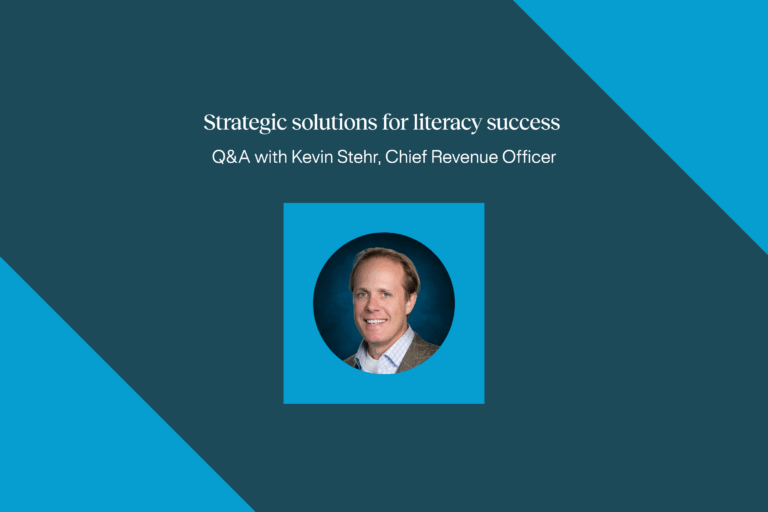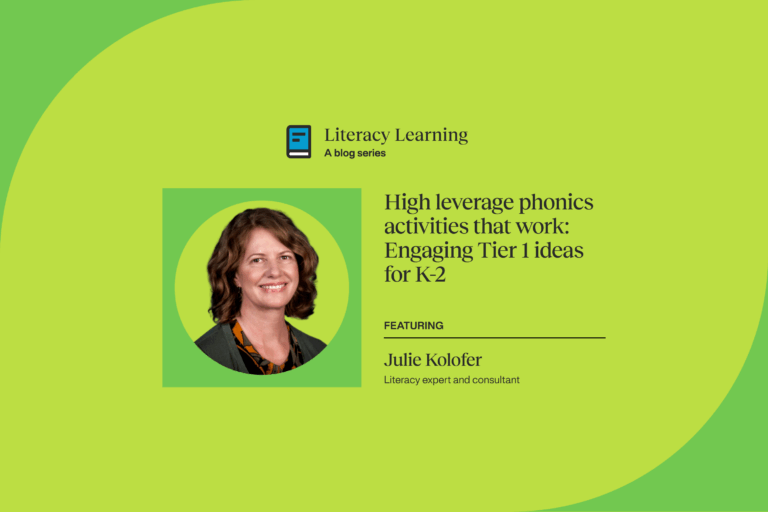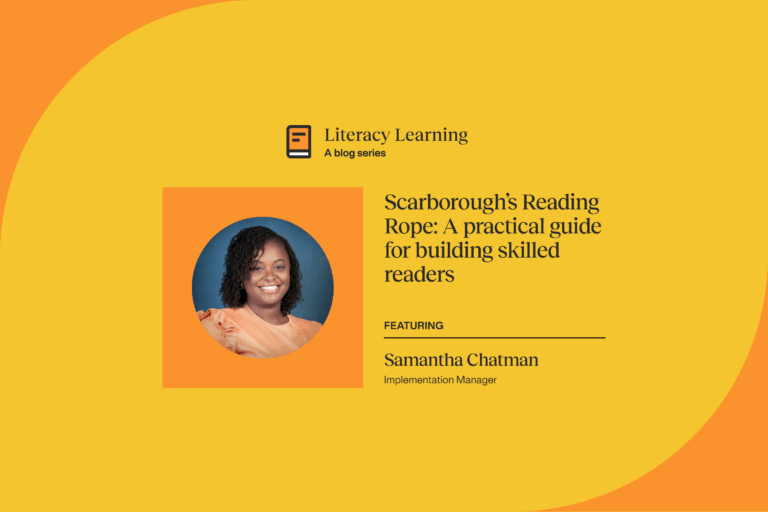Reading instruction for grades four and five
Most fourth and fifth grade classroom teachers across the country share an expectation that their students have mastered reading basics in K-3. In grades 4 and 5, teachers are prepared to help students dive right in and navigate complex, grade-level text in all subject areas.

But the data on fourth grade reading tells a different story. The 2022 National Assessment of Educational Progress, known as “The Nation’s Report Card,” revealed that 65 percent of fourth graders scored basic or below in the NAEP reading achievement levels. NAEP reports: “At fourth grade, the average reading score was lower than all previous assessment years going back to 2005 and was not significantly different in comparison to 1992.” Or to say it simply, fourth grade reading scores are the lowest they’ve been in 30 years. The need to address this decline—attributed mainly to unfinished learning and underlying phonics gaps—is urgent.
The High Stakes of Failure
At the same time reading scores have dipped to a 30-year low, the need for literacy skills required to function in the 21st century has never been greater. Drilling deeper into the research on reading and illiteracy reveals the high stakes of failure. Starting early in school, students who struggle face a potential downward spiral as the distance grows between where they are and the increasing complexity of text demands. About 16 percent of children who are not reading proficiently by the end of third grade do not graduate from high school, a rate four times greater than that for proficient readers (Annie E. Casey Foundation, 2012). And 85 percent of all juveniles involved in the juvenile court system are functionally low-literate. We know that juvenile incarceration reduces the possibility of high school graduation and increases the probability of incarceration later in life (Aizer & Doyle, 2015).
Reading in Grades Four and Five
A robust instructional program in grades four and five recognizes that the goal is for students to read sufficiently complex text with fluency and understanding. A well-rounded instructional approach includes building students’ knowledge of words and of the world (background knowledge and vocabulary), fluency-building, instruction in appropriate, evidence-aligned comprehension strategies and comprehension-monitoring, along with rich discussions, including asking and answering questions, to support students’ ability to make sense of challenging texts and complex ideas. In addition, a strong instructional approach includes a word study component, specifically aimed at developing and securing students’ abilities to decode and make meaning of the words they will encounter.
“Heavy Hitters” in Intermediate Word Study
How can a teacher address key reading word study skills that are needed in the intermediate grades? First instruction must include accurate assessments on a student’s word-reading ability. If students need intervention in the basic letter-sound combinations and monosyllabic decoding, teachers must provide that intervention.
Second, instruction in grades four and five needs to carry on with the foundation that began in K-3 and include the “heavy hitters” of intermediate word study: multisyllabic decoding and morphology. Why are these considered “heavy hitters?” Once students have internalized routines for multisyllabic decoding, those routines can be applied to any multisyllabic word. Because of the generalizable nature of units of our language, as students increase their understanding of morphemes—the smallest unit of meaning within a word, or a word itself—they can exponentially increase their ability to decode and understand the increasing numbers of unfamiliar words they encounter as they move through the grades.
It is important to note that syllables are NOT the same as morphemes. These are two elements of multisyllabic words that help us read unfamiliar words. Students in the “consolidated” phase of word reading development (Ehri, 1998) quickly apply their knowledge of both syllables and morphemes to decode and understand words.
The Importance of Multisyllabic Decoding
As students move through higher grades, the demands on their ability to decode complex words increase. While students may have mastered monosyllabic words in the early grades, many students today enter grades 4 and 5 with no particular strategies for decoding multisyllabic words. Yet according to research, they’re faced with an “orthographic avalanche” (Share, 1995; p. 153) of 10 to 20,000 new multisyllabic words in print per year. Without the tools for unlocking these words, students may read them incorrectly or skip them altogether. Many students with reading difficulties may recognize the beginning letters and guess at the rest of the word. Without the ability to decode multisyllabic words, students fail to comprehend what they read (Heggie & Wade-Woolley, 2017; p. 88).
In The What Works Practice Guide: Providing Reading Interventions for Students in Grades 4-9 (March, 2022), expert panelists assigned a strong level of evidence to the recommendation that instruction builds students’ decoding skills so they can read multisyllabic words. Specific ways to carry out this recommendation include teaching students a routine they can use for decoding multisyllabic words. This requires explicit instruction in syllable types, division rules, and breaking apart words utilizing syllabication routines. Other instructional techniques include embedding spelling (or encoding) practice along with decoding practice, and providing students with a wide array of opportunities to practice reading multisyllabic words accurately and with increasing automaticity.
The Importance of Morphology
Research shows that “acquiring knowledge of how morphology underpins the mapping between spelling and meaning is also an important process in the development of skilled reading.” We’ve learned, especially with older students who are behind, that rather than go back and teach every letter sound and every vowel pattern, going right to explicit instruction in morphology can close the skill gap—students will pick up some of those previously missed skills from the morphological units.
Just like instruction in multisyllabic decoding, instruction in morphology must be explicit and routinized to maximize efficiency of teaching and learning; a routine includes teaching affixes and roots along with practice in identifying and defining words based on these morphological units. Instruction also includes a wide array of practice reading text to apply their knowledge of morphemes.
Helping Intermediate Grade Teachers Meet the Challenge
Fourth and fifth grade teachers are trained to help their students succeed in the goals of their grade’s curriculum—navigating through text as a more sophisticated reader. Yet many teachers in the intermediate grades have not been provided with a strong background in evidence-aligned word study practices to both accelerate their below-level students’ learning and consolidate all students’ learning to ensure they are able to read grade-level text with fluency and understanding.
For example, Anne Castles, professor of cognitive science and scientific director of the Macquarie University Centre for Reading, writes that “research has shown that teacher knowledge of morphology is sparse and patchy, and many teachers are unaware of the ways in which morphemes communicate meaning and govern spelling construction (Hurry et al., 2005). This seems to be a critical gap in teacher knowledge.”
Where does a teacher begin? There are many good, accessible resources on the Science of Reading for beginners here. For specific information on syllable types, this article in Reading Rockets is helpful, as is this article on morphology from the same source. And school leadership needs to support their teachers too. Professional learning and ongoing coaching are critical in developing the mastery of effective literacy instruction in 4th and 5th grades.
While building our collective understanding of effective word study practices is important, it is critical to have the right materials and best practices available for teachers.
Learn More
To read more by Laura Stewart and her list of recommended resources, visit her most recent reflection on episode 5 of the Sold a Story podcast.
At 95 Percent Group, we are dedicated to producing evidence-aligned resources, by educators and for educators, that link research to practice. If you’d like to learn more about what we offer, please get in touch.
ABOUT LAURA STEWART
Laura Stewart, Chief Academic Officer, is a nationally recognized Science of Reading and Structured Literacy advocate and expert who will serve as the company’s spokesperson and will continue to build its thought leadership position in the literacy market. Stewart has dedicated her career to improving literacy achievement at leading education companies including The Reading League, Highlights Education Group, and Rowland Reading Foundation.



